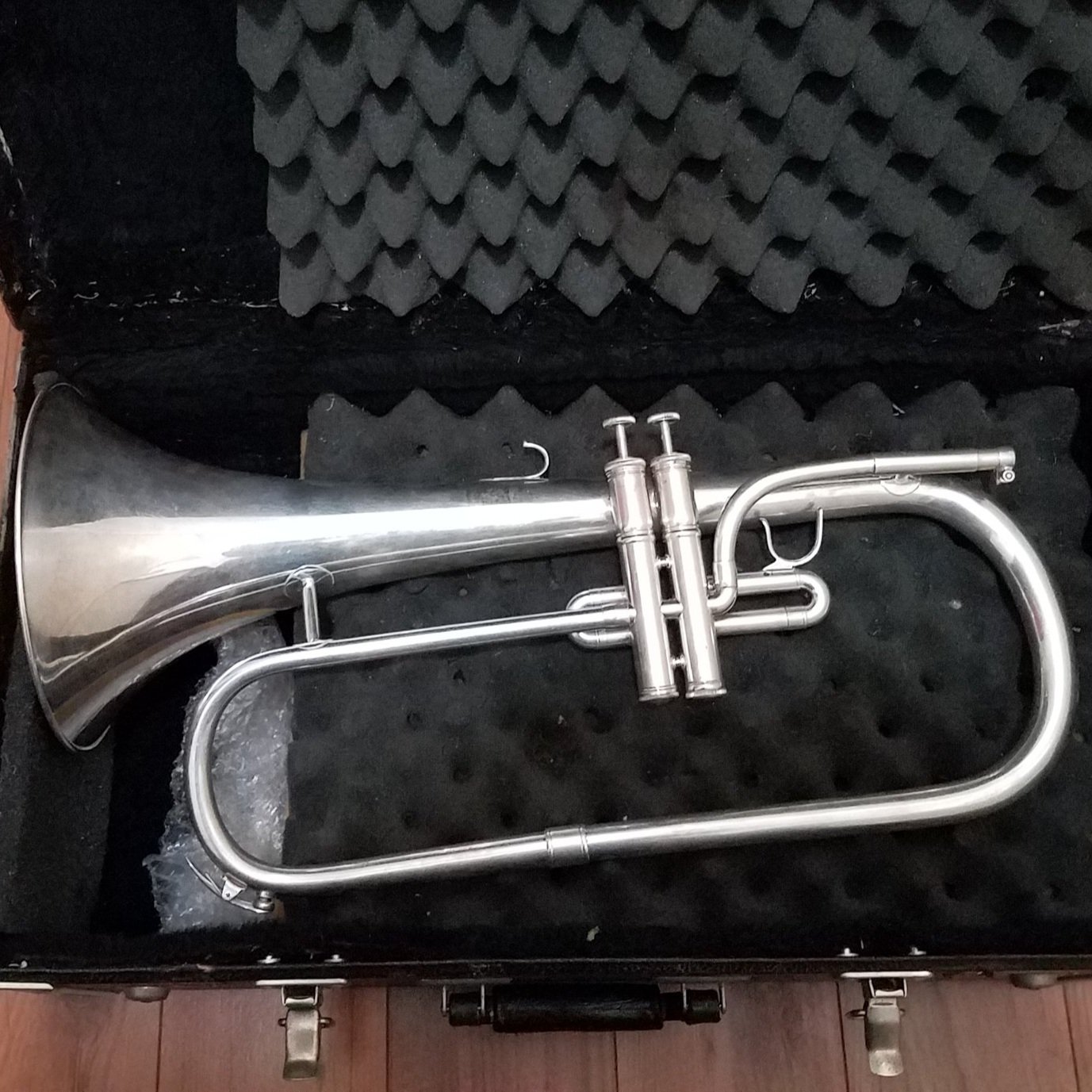Meehaphone
The Meehaphone is an enormously rare breed of 2-valve competition bugle in G, built and used from 1987 to 1991. It was designed by Jack Meehan and Zig Kanstul for the Concord Blue Devils drum and bugle corps, in an effort to streamline their middle voice section from three types of G bugle (mellophone, flugelhorn, and French horn) to one.
The exact number built is not certain, but as the meehaphones were built by Kanstul specifically for the Blue Devils, it is likely that there were only enough made to fill out the corps’ mid-voice section. It seems that at the time the Blue Devils’ mid-voice was consistently 14 players, based on instrumentations noted in this Middle Horn Leader interview with Wayne Downey and my own studying of the relevant footage online. It is thus reasonable to conclude that there were most likely 14 production meehaphones built. There was also at least one prototype built in F with 3 valves, which is now owned by Bobby Pirtle and resembles a giant flugelhorn.
According to the late Ken Norman, the meehaphone has a bell flare identical to the Olds BU-10 and Conn 92L French horn bugles, mated to a 2-valve .415” bore flugelhorn body. It is essentially a bell-front field descant horn in G. At the time, Terry Warburton made custom mouthpieces for the meehaphones, labelled “Downey BD”. The Blue Devils used an all-meehaphone alto section for the 1987-1990 DCI seasons, and in 1991 they used 4 mellophones and 10 meehaphones. The meehaphones were shelved shortly thereafter when new 3-valve G flugelhorns from Yamaha arrived.
According to all accounts, they were the loudest alto bugle ever created. In fact, on the bell is stamped “MFL”, which does not stand for “Marching Flugelhorn” but “Mother F***ing Loud”! They had a darker sound than mellophones and projected very well, but notes above written G at the top of the staff (sounding D5) were very hard to center. Here’s the Blue Devils’ 1988 show on YouTube, with plenty of meehaphone action to go around. After 1991, the meehaphones fell off the map. Most of them were lost in a single shipment, which has never been found. There are only a handful whose whereabouts are known, and all but one are on display in various states of functionality in drum corps-related museums.
So, that’s the lore…now, here’s my practical experience.
Here is an original Kanstul meehaphone, serial #1028, that I had the privilege of owning for a while. It was previously owned by Ken Norman, and is the single known example not in a museum.
When played softly, it has a French flugelhorn-like quality to the sound, which makes sense considering the .415” flugel leadpipe and valve block. When pushed, it gets bright with a trumpet-like edge, but without what I would describe as the mellophone’s tearing metal zing. It’s a very interesting sound that’s clearly related to my other alto bugles, but at the same time standing apart from them.
But don’t let me just talk about how it sounds. Have a listen for yourself!
These clips were all recorded close-miced into a Cascade Fat Head ribbon microphone and SSL2 audio interface. The ensemble excerpt in particular provides a good summary of the meehaphone’s qualities…both good and bad. The notes above the staff live up to their squirrelly reputation; while I could play them effectively (I suspect thanks to my Conn 16E experience), it is certainly a treacherous register. In general the intonation isn’t the best, but it’s nowhere near the worst I’ve played either.
It’s important to note that I did not have an original Downey BD mouthpiece made by Terry Warburton for the meehaphones. Mine came with a Burbank F mouthpiece with a cylindrical shank, and while it worked I didn’t feel that it was an ideal mouthpiece for the instrument.
For more playing and practical information about the meehaphone, check out this video:
Meehaphone (left) next to Couesnon flugelhorn (right)



